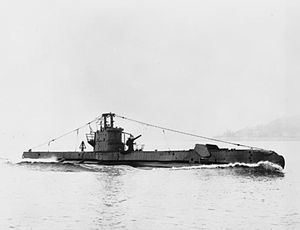Name HMS Sea Rover Commissioned 7 July 1943 Construction started 14 April 1941 Length 66 m Draft 4.47 m | Laid down 14 April 1941 Class and type S-class submarine Launched 8 February 1943 Test depth 91 m | |
 | ||
Fate Sold for scrap, October 1949 Displacement 842 long tons (856 t) surfaced
990 long tons (1,010 t) submerged Builder Scotts Shipbuilding and Engineering Company | ||
HMS Sea Rover was a S-class submarine of the third batch built for the Royal Navy during World War II. She survived the war and was sold for scrap in 1949.
Contents
Design and description
The third batch was slightly enlarged and improved over the preceding second batch of the S-class. The submarines had a length of 217 feet (66.1 m) overall, a beam of 23 feet 9 inches (7.2 m) and a draft of 14 feet 8 inches (4.5 m). They displaced 842 long tons (856 t) on the surface and 990 long tons (1,010 t) submerged. The S-class submarines had a crew of 48 officers and ratings. They had a diving depth of 300 feet (91.4 m).
For surface running, the boats were powered by two 950-brake-horsepower (708 kW) diesel engines, each driving one propeller shaft. When submerged each propeller was driven by a 650-horsepower (485 kW) electric motor. They could reach 15 knots (28 km/h; 17 mph) on the surface and 10 knots (19 km/h; 12 mph) underwater. On the surface, the third batch boats had a range of 6,000 nautical miles (11,000 km; 6,900 mi) at 10 knots (19 km/h; 12 mph) and 120 nmi (220 km; 140 mi) at 3 knots (5.6 km/h; 3.5 mph) submerged.
The boats were armed with seven 21-inch (533 mm) torpedo tubes. A half-dozen of these were in the bow and there was one external tube in the stern. They carried six reload torpedoes for the bow tubes for a total of thirteen torpedoes. Twelve mines could be carried in lieu of the internally stowed torpedoes. They were also armed with a 3-inch (76 mm) deck gun.
Construction and career
HMS Sea Rover was built by Scotts, of Greenock and launched on 8 February 1943. Thus far she has been the only ship of the Royal Navy to bear the name Sea Rover. The boat spent most of her career in the Far East, where she sank a number of Japanese ships, including the ship Matsu Maru No.1, the transport Shobu Maru, the auxiliary gunboat Koshu Maru, three sailing vessels, a coaster and four unidentified Japanese vessels. Sea Rover survived the Second World War, and was sold in October 1949 before being broken up at Faslane from June 1950.
